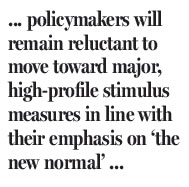
The economic data for Jan 20 showed that, on a quarterly basis, the slowdown of China’s economy was interrupted in the fourth quarter of 2014. However, for the year as a whole, GDP growth slowed from 7.7 percent in 2013 to 7.4 percent last year, slightly below the official target of 7.5 percent, the first time this has happened since 1998.
The economic slowdown was especially visible in industry, particularly heavy industry, which was jolted by the real estate downturn and where the impact of the slowdown on corporate activity and profits is amplified by falling output prices.
Activity and price developments in light industry and the service sector were more favorable. Indeed, we (at Royal Bank of Scotland) saw further rebalancing of the pattern of growth in 2014. As the share of the secondary (industrial) sector fell 1.3 percentage points to 42.6 percent of GDP, the service sector’s share increased 2.1 percentage points to 48.2 percent, even though the rebalancing on this dimension was less rapid in real terms.
The relatively favorable growth of the comparatively labor-intensive service sector supported the labor market. With real service sector GDP growth edging down from 8.3 percent in 2013 to 8.1 percent last year, new urban job creation — the government’s preferred labor-market indicator — was 10.7 million, exceeding the target of 10 million. Migrant employment growth — a good indicator on the vibrancy of the urban labor market — picked up slightly in the fourth quarter of last year, after an earlier slowdown.
The relatively good labor market performance through 2014 was an important reason why China’s leadership remained relatively restrained with regard to macroeconomic stimulus and a reason the leadership thought it acceptable for growth to slightly miss the growth target in 2014.
Inflation faces downward pressure because of falling prices of raw commodities on global markets and overcapacity in China’s industry, although the likelihood of a pernicious deflationary spiral is not high.
Economic growth is likely to remain under downward pressure in the first half of 2015, affected by continued real estate weakness. In spite of measures to stimulate housing sales taken in the second half of last year, a real estate recovery is not likely any time soon. Although low raw commodity prices should support margins in industry, corporate investment momentum will probably not improve much either in 2015, given the weak demand prospects and overcapacity in several sectors.

I’ve lived in China for quite a considerable time including my graduate school years, travelled and worked in a few cities and still choose my destination taking into consideration the density of smog or PM2.5 particulate matter in the region.